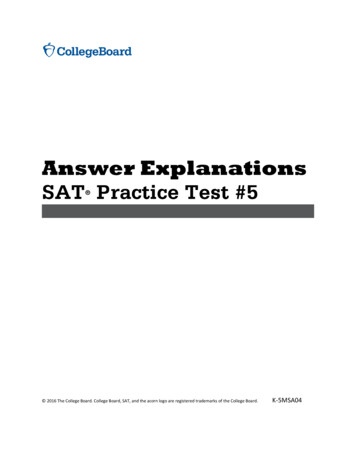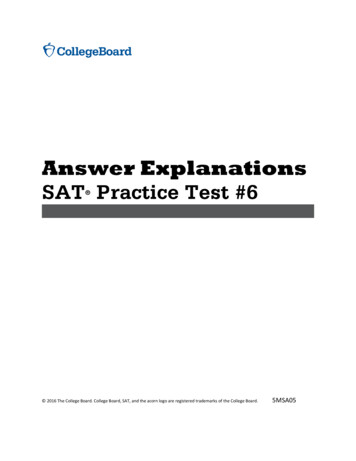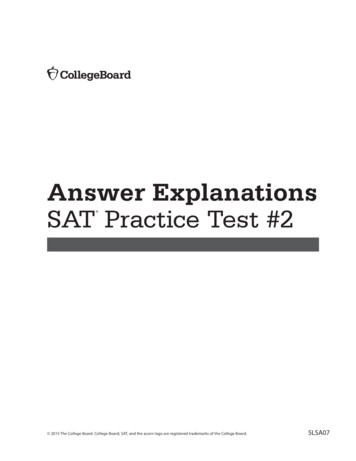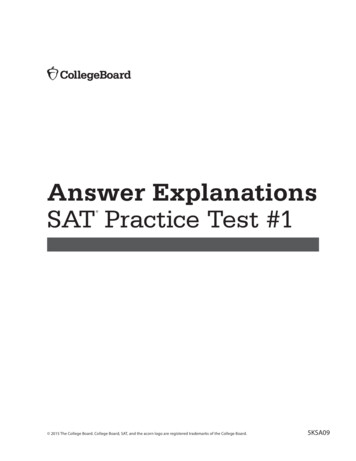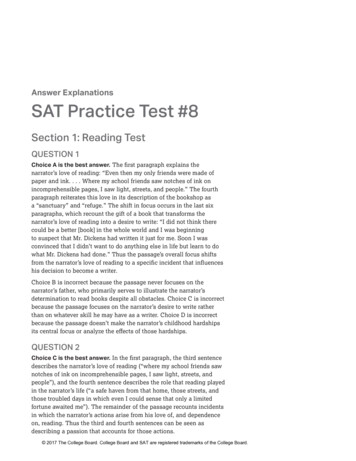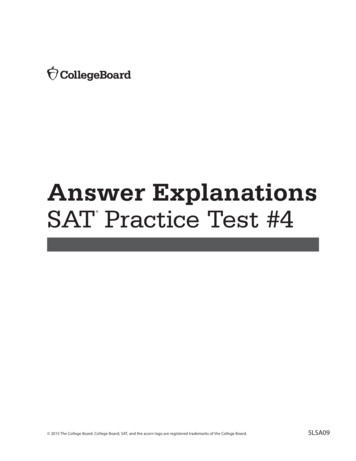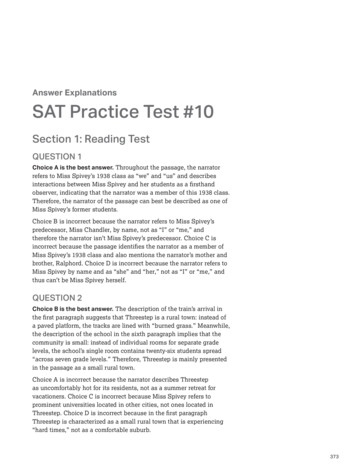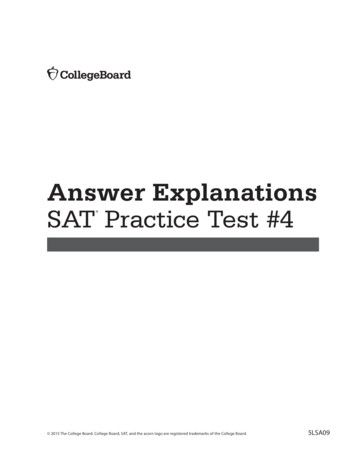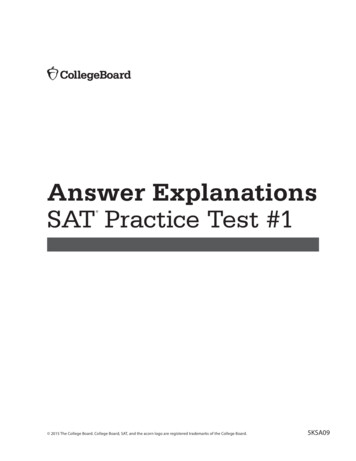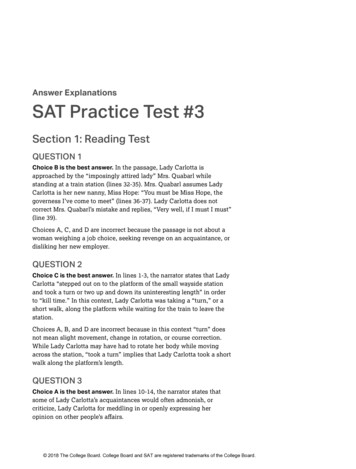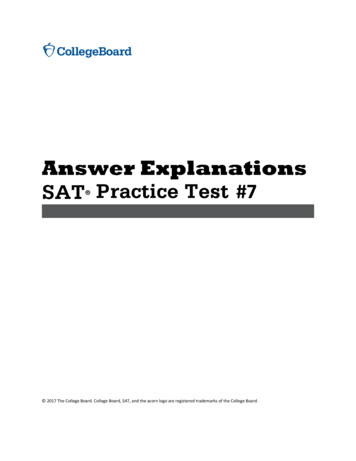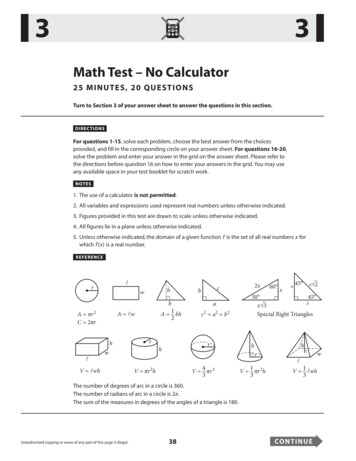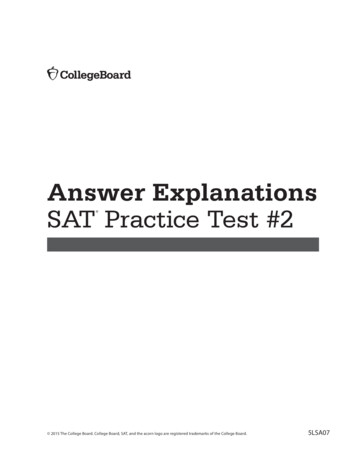
Transcription
Answer ExplanationsSAT Practice Test #2 2015 The College Board. College Board, SAT, and the acorn logo are registered trademarks of the College Board.5LSA07
Answer ExplanationsSAT Practice Test #2Section 1: Reading TestQUESTION 1.Choice A is the best answer. The narrator admits that his job is “irksome”(line 7) and reflects on the reasons for his dislike. The narrator admits thathis work is a “dry and tedious task” (line 9) and that he has a poor relationship with his superior: “the antipathy which had sprung up between myselfand my employer striking deeper root and spreading denser shade daily,excluded me from every glimpse of the sunshine of life” (lines 28-31).Choices B, C, and D are incorrect because the narrator does not becomeincreasingly competitive with his employer, publicly defend his choice ofoccupation, or exhibit optimism about his job.QUESTION 2.Choice B is the best answer. The first sentence of the passage explains thatpeople do not like to admit when they’ve chosen the wrong profession andthat they will continue in their profession for a while before admitting theirunhappiness. This statement mirrors the narrator’s own situation, as thenarrator admits he finds his own occupation “irksome” (line 7) but that hemight “long have borne with the nuisance” (line 10) if not for his poor relationship with his employer.Choices A, C, and D are incorrect because the first sentence does not discussa controversy, focus on the narrator’s employer, Edward Crimsworth, or provide any evidence of malicious conduct.QUESTION 3.Choice C is the best answer. The first paragraph shifts from a general dis-cussion of how people deal with choosing an occupation they later regret(lines 1-6) to the narrator’s description of his own dissatisfaction with hisoccupation (lines 6-33).1
Choices A, B, and D are incorrect because the first paragraph does not focuson the narrator’s self-doubt, his expectations of life as a tradesman, or hisidentification of alternatives to his current occupation.QUESTION 4.Choice A is the best answer. In lines 27-33, the narrator is describing thehostile relationship between him and his superior, Edward Crimsworth.This relationship causes the narrator to feel like he lives in the “shade” andin “humid darkness.” These words evoke the narrator’s feelings of dismaytoward his current occupation and his poor relationship with his superior—factors that cause him to live without “the sunshine of life.”Choices B, C, and D are incorrect because the words “shade” and “darkness”do not reflect the narrator’s sinister thoughts, his fear of confinement, or hislonging for rest.QUESTION 5.Choice D is the best answer. The narrator states that Crimsworth dis-likes him because the narrator may “one day make a successful tradesman” (line 43). Crimsworth recognizes that the narrator is not “inferiorto him” but rather more intelligent, someone who keeps “the padlock ofsilence on mental wealth which [Crimsworth] was no sharer” (lines 44-48).Crimsworth feels inferior to the narrator and is jealous of the narrator’sintellectual and professional abilities.Choices A and C are incorrect because the narrator is not described as exhibiting “high spirits” or “rash actions,” but “Caution, Tact, [and] Observation”(line 51). Choice B is incorrect because the narrator’s “humble background”is not discussed.QUESTION 6.Choice B is the best answer. Lines 61-62 state that the narrator “hadlong ceased to regard Mr. Crimsworth as my brother.” In these lines, theterm “brother” means friend or ally, which suggests that the narrator andCrimsworth were once friendly toward one another.Choices A, C, and D are incorrect because the narrator originally viewedCrimsworth as a friend, or ally, and later as a hostile superior; he never viewedCrimsworth as a harmless rival, perceptive judge, or demanding mentor.QUESTION 7.Choice D is the best answer. In lines 61-62, the narrator states that he onceregarded Mr. Crimsworth as his “brother.” This statement provides evidencethat the narrator originally viewed Crimsworth as a sympathetic ally.2
Choices A, B, and C do not provide the best evidence for the claim thatCrimsworth was a sympathetic ally. Rather, choices A, B, and C provide evidence of the hostile relationship that currently exists between the narratorand Crimsworth.QUESTION 8.Choice D is the best answer. In lines 48-53, the narrator states that he exhibited “Caution, Tact, [and] Observation” at work and watched Mr. Crimsworthwith “lynx-eyes.” The narrator acknowledges that Crimsworth was “preparedto steal snake-like” if he caught the narrator acting without tact or being disrespectful toward his superiors (lines 53-56). Thus, Crimsworth was tryingto find a reason to place the narrator “in a ridiculous or mortifying position”(lines 49-50) by accusing the narrator of acting unprofessionally. The use ofthe lynx and snake serve to emphasize the narrator and Crimsworth’s adversarial, or hostile, relationship.Choices A and B are incorrect because the description of the lynx and snakedoes not contrast two hypothetical courses of action or convey a resolution.Choice C is incorrect because while lines 48-56 suggest that Crimsworth istrying to find a reason to fault the narrator’s work, they do not imply that analtercation, or heated dispute, between the narrator and Crimsworth is likelyto occur.QUESTION 9.Choice B is the best answer. Lines 73-74 state that the narrator noticedthere was no “cheering red gleam” of fire in his sitting-room fireplace. Thelack of a “cheering,” or comforting, fire suggests that the narrator sometimesfound his lodgings to be dreary or bleak.Choices A and D are incorrect because the narrator does not find his living quarters to be treacherous or intolerable. Choice C is incorrect becausewhile the narrator is walking home he speculates about the presence of a firein his sitting-room’s fireplace (lines 69-74), which suggests that he could notpredict the state of his living quarters.QUESTION 10.Choice D is the best answer. In lines 68-74, the narrator states that he did notsee the “cheering” glow of a fire in his sitting-room fireplace. This statementprovides evidence that the narrator views his lodgings as dreary or bleak.Choices A, B, and C do not provide the best evidence that the narrator viewshis lodgings as dreary. Choices A and C are incorrect because they do notprovide the narrator’s opinion of his lodgings, and choice B is incorrectbecause lines 21-23 describe the narrator’s lodgings only as “small.”3
QUESTION 11.Choice D is the best answer. In lines 11-12, the author introduces themain purpose of the passage, which is to examine the “different views onwhere ethics should apply when someone makes an economic decision.”The passage examines what historical figures Adam Smith, Aristotle,and John Stuart Mill believed about the relationship between ethicsand economics.Choices A, B, and C are incorrect because they identify certain pointsaddressed in the passage (cost-benefit analysis, ethical economic behavior, and the role of the free market), but do not describe the passage’smain purpose.QUESTION 12.Choice D is the best answer. In lines 4-5, the author suggests that peopleobject to criticizing ethics in free markets because they believe free markets are inherently ethical, and therefore, the role of ethics in free marketsis unnecessary to study. In the opinion of the critics, free markets are ethical because they allow individuals to make their own choices about whichgoods to purchase and which goods to sell.Choices A and B are incorrect because they are not objections that criticizethe ethics of free markets. Choice C is incorrect because the author does notpresent the opinion that free markets depend on devalued currency.QUESTION 13.Choice A is the best answer. In lines 4-5, the author states that some peoplebelieve that free markets are “already ethical” because they “allow for personal choice.” This statement provides evidence that some people believecriticizing the ethics of free markets is unnecessary because free marketspermit individuals to make their own choices.Choices B, C, and D are incorrect because they do not provide the best evidence of an objection to a critique of the ethics of free markets.QUESTION 14.Choice B is the best answer. In lines 6-7, the author states that people “haveaccepted the ethical critique and embraced corporate social responsibility.”In this context, people “embrace,” or readily adopt, corporate social responsibility by acting in a certain way.Choices A, C, and D are incorrect because in this context “embraced” doesnot mean lovingly held, eagerly hugged, or reluctantly used.4
QUESTION 15.Choice C is the best answer. The third and fourth paragraphs of the passagepresent Adam Smith’s and Aristotle’s different approaches to defining ethicsin economics. The fifth paragraph offers a third approach to defining ethicaleconomics, how “instead of rooting ethics in character or the consequencesof actions, we can focus on our actions themselves. From this perspectivesome things are right, some wrong” (lines 45-48).Choice A is incorrect because the fifth paragraph does not develop a counterargument. Choices B and D are incorrect because although “character” isbriefly mentioned in the fifth paragraph, its relationship to ethics is examined in the fourth paragraph.QUESTION 16.Choice A is the best answer. In lines 57-59, the author states that “Manymoral dilemmas arise when these three versions pull in different directionsbut clashes are not inevitable.” In this context, the three different perspectives on ethical economics may “clash,” or conflict, with one another.Choices B, C, and D are incorrect because in this context “clashes” does notmean mismatches, collisions, or brawls.QUESTION 17.Choice C is the best answer. In lines 59-64, the author states, “Take fairtrade coffee . . . for example: buying it might have good consequences, bevirtuous, and also be the right way to act in a flawed market.” The authoris suggesting that in the example of fair trade coffee, all three perspectivesabout ethical economics—Adam Smith’s belief in consequences dictatingaction, Aristotle’s emphasis on character, and the third approach emphasizing the virtue of good actions—can be applied. These three approaches share“common ground” (line 64), as they all can be applied to the example of fairtrade coffee without contradicting one another.Choices A, B, and D are incorrect because they do not show how the threedifferent approaches to ethical economics share common ground. Choice Asimply states that there are “different views on ethics” in economics, choiceB explains the third ethical economics approach, and choice D suggests thatpeople “behave like a herd” when considering economics.QUESTION 18.Choice C is the best answer. In lines 83-88, the author states that psychol-ogy can help “define ethics for us,” which can help explain why people “reactin disgust at economic injustice, or accept a moral law as universal.”5
Choices A and B are incorrect because they identify topics discussed in thefinal paragraph (human quirks and people’s reaction to economic injustice)but not its main idea. Choice D is incorrect because the final paragraphdoes not suggest that economists may be responsible for reforming thefree market.QUESTION 19.Choice A is the best answer. The data in the graph show that in Tanzaniabetween the years 2000 and 2008, fair trade coffee profits were around 1.30 per pound, while profits of regular coffee were in the approximaterange of 20–60 cents per pound.Choices B, C, and D are incorrect because they are not supported by information in the graph.QUESTION 20.Choice B is the best answer. The data in the graph indicate that between2002 and 2004 the difference in per-pound profits between fair trade andregular coffee was about 1. In this time period, fair trade coffee was valued at around 1.30 per pound and regular coffee was valued at around20 cents per pound. The graph also shows that regular coffee recordedthe lowest profits between the years 2002 and 2004, while fair tradecoffee remained relatively stable throughout the entire eight-year span(2000 to 2008).Choices A, C, and D are incorrect because they do not indicate the greatestdifference between per-pound profits for fair trade and regular coffee.QUESTION 21.Choice C is the best answer. In lines 59-61, the author defines fair tradecoffee as “coffee that is sold with a certification that indicates the farmersand workers who produced it were paid a fair wage.” This definition suggests that purchasing fair trade coffee is an ethically responsible choice, andthe fact that fair trade coffee is being produced and is profitable suggeststhat ethical economics is still a consideration. The graph’s data support thisclaim by showing how fair trade coffee was more than twice as profitable asregular coffee.Choice A is incorrect because the graph suggests that people acting onempathy (by buying fair trade coffee) is productive for fair trade coffeefarmers and workers. Choices B and D are incorrect because the graph doesnot provide support for the idea that character or people’s fears factor intoeconomic choices.6
QUESTION 22.Choice C is the best answer. The author of Passage 1 indicates that peoplecan benefit from using screen-based technologies as these technologiesstrengthen “certain cognitive skills” (line 3) and the “brain functions relatedto fast-paced problem solving” (lines 14-15).Choice A is incorrect because the author of Passage 1 cites numerous studiesof screen-based technologies. Choice B is incorrect because it is not supported by Passage 1, and choice D is incorrect because while the authormentions some benefits to screen-based technologies, he does not encourage their use.QUESTION 23.Choice A is the best answer. In lines 3-4, the author of Passage 1 pro-vides evidence that the use of screen-based technologies has some positiveeffects: “Certain
Answer Explanations SAT Practice Test #2 Section 1: Reading Test QUESTION 1. Choice A is the best answer. The narrator admits that his job is “irksome” (line 7) and reflects on the reasons for his dislike. The narrator admits that his work is a “dry and tedious task” (line 9) and that he has a poor relation- ship with his superior: “the antipathy which had sprung up between myself .
